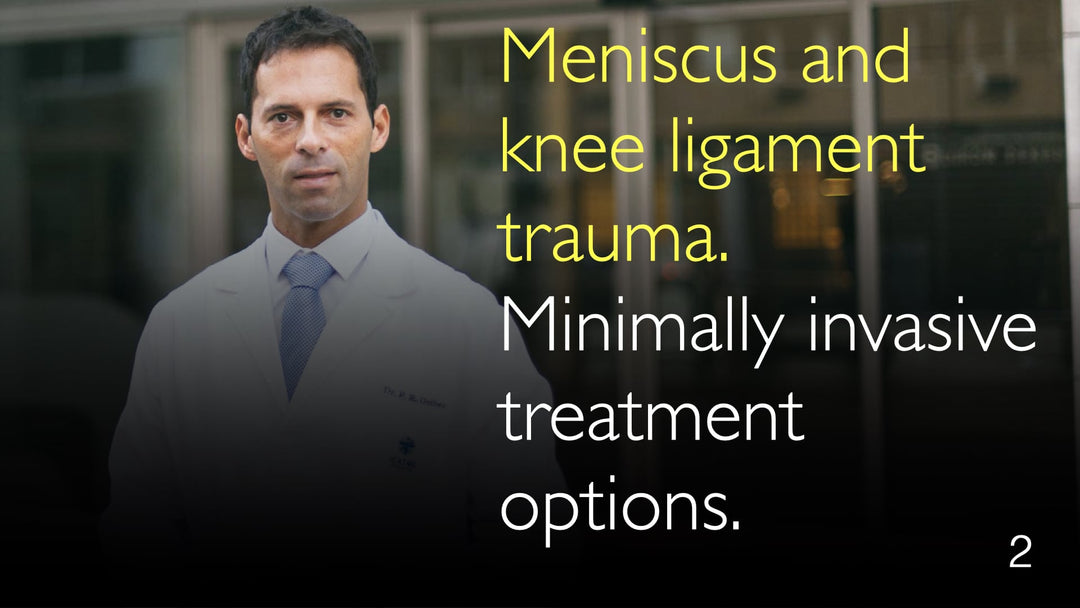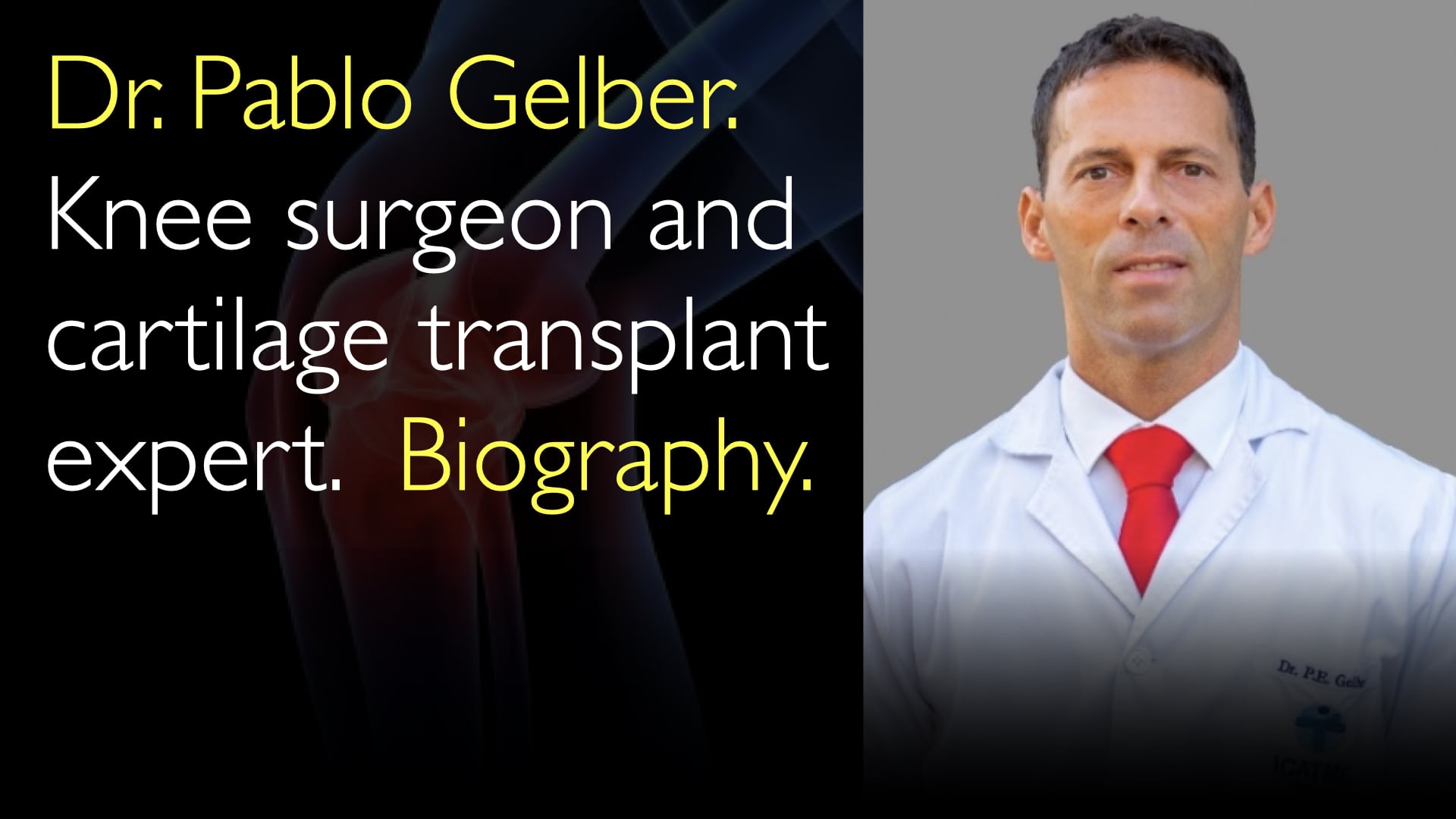Polvivammojen ja vähäinvasiivisen kirurgian asiantuntijajohtaja, lääketieteen tohtori Pablo Gelber, selittää, miksi henkilökohtaiset hoitosuunnitelmat ovat välttämättömiä nivelruston repeämien, nivelsidevammojen ja rustovaurioiden hoidossa. Hän kuvailee yksityiskohtaisesti biologisten hoitomuotojen, kuten rustonsiirtojen, ratkaisevaa merkitystä nuorten, aktiivisten potilaiden polven tekonivelleikkauksen lykkäämisessä. Samalla hän selventää, milloin osittainen tai täydellinen niveltekonivelleikkaus muodostuu tarpeelliseksi ”metalliratkaisuksi” vaikeaan, paikalliseen nivelrikkoon.
Räätälöity polvivamman hoito: biologisesta korjauksesta nivelvaihtoon
Hyppää osioon
- Räätälöity hoitofilosofia polvivammalle
- Metalliratkaisujen rooli polvivammassa
- Rustosiirto täyttää kriittisen aukon hoidossa
- Osittaiset nivelvaihdot paikalliselle vauriolle
- Miksi kirurgit välttävät nivelvaihtoa nuorilla potilailla
- Proteesin vikaantuminen ja korkeammat uusintaleikkausmäärät
Räätälöity hoitofilosofia polvivammalle
Lääketieteen tohtori Pablo Gelber korostaa, että yhden mallin soveltaminen kaikkiin -hoito on tehoton polvivammoille. Hänen mukaansa jokainen potilas tarvitsee yksilöllisen hoitosuunnitelman, joka perustuu potilaan diagnoosiin, ikään ja aktiivisuustasoon. Tämä lähestymistapa on ratkaisevan tärkeä monimutkaisten polvivammojen hoidossa, jotka koskevat nivelrustoa, nivelsiteitä ja rustokudosta.
Gelberin mukaan 20-vuotiaan urheilijan revähtänyt polvenside vaatii täysin erilaisen hoitostrategian kuin sama vamma 50-vuotiaalla. Nuorelle potilaalle autologinen rustosiirto – potilaan omasta kudoksesta – voi olla optimaalinen. Iäkkäämmälle allogeeninen siirto eli luovuttajan kudoksesta saattaa olla parempi vaihtoehto. Tässä yksilöllisessä päätöksenteossa huomioidaan tuhansia muuttujia parhaan pitkäaikaistuloksen saavuttamiseksi.
Metalliratkaisujen rooli polvivammassa
Vaikka Gelber keskittyy biologisiin ja konservatiivisiin hoitoihin, hän vahvistaa, että metalliratkaisuilla kuten nivelvaihdoilla on selkeä paikkansa hoitoalgoritmeissa. Hän suorittaa kaikenlaisia polvileikkauksia eikä sulje pois nivelvaihtoa, kun se on potilaan tilanteeseen paras vaihtoehto.
Metalliratkaisut tulevat tarpeellisiksi, kun muut hoidot eivät ole onnistuneet tai mahdollisia. Joillekin potilaille rustosiirto ei ole vaihtoehto, mikä luo merkittävän hoidollisen aukon. Näissä tapauksissa suora siirtyminen nivelvaihtoon voi olla ainoa tapa palauttaa toiminta ja lievittää kipua, mikä tekee siitä välttämättömän työkalun kirurgin repertoaarissa.
Rustosiirto täyttää kriittisen aukon hoidossa
Tohtori Gelber pitää tuoretta osteokondraalista allografiirustosiirtoa keskeisenä biologisena hoidona, joka täyttää kriittisen aukon polvivammahoidossa. Toimenpide on suunniteltu potilaille, jotka ovat liian nuoria metallinivelvaihdolle, mutta joille muut konservatiiviset hoidot eivät riitä.
Tässä kehittyneessä tekniikassa siirretään tervettä rustoa ja luuta luovuttajalta potilaan vaurioituneeseen polveen. Se viivästyttää tehokkaasti tarvetta proteesille ja ostaa arvokasta aikaa nuoremmille aktiivisille potilaille. Gelber korostaa tämän käytäntönsä kulmakivenä, tarjoten pitkäaikaisempia ratkaisuja lyhytaikaisien korjausten sijaan.
Osittaiset nivelvaihdot paikalliselle vauriolle
Kaikki metalliratkaisut eivät vaadi täydellistä nivelvaihtoa. Gelber kuvailee osittaisia nivelvaihtoja vähemmän invasiivisena vaihtoehtona potilaille, joilla on vaikea nivelrikko yhdessä polven osastossa. Polvessa on kolme osastoa: mediaalinen (sisäinen), lateraalinen (ulkoinen) ja patellofemoraalinen (etummainen).
Kun vaurio on rajoittunut yhteen alueeseen, kirurgi voi suorittaa unikondyylaarisen polven nivelvaihdon (sisä- tai ulkopuolelle) tai patellofemoraalisen nivelvaihdon (polvilumpio). Nämä toimenpiteet säästävät terveet luut ja kudokset vaurioitumattomista osastoista, tarjoten konservatiivisemman metalliratkaisun nopeammalla toipumisella sopiville 50–55-vuotiaille potilaille.
Miksi kirurgit välttävät nivelvaihtoa nuorilla potilailla
Ensisijainen tavoite nuorten potilaiden hoidossa on viivästyttää metalliratkaisua mahdollisimman pitkään. Gelber määrittelee "nuoriksi" potilaiksi 40–55-vuotiaita. Haluttomuus nivelvaihtoon ei johdu sen tehottomuudesta, vaan siitä että proteesit eivät kestä elinikääistä rasitusta korkean kuormituksen olosuhteissa.
Nuoremmat potilaat rasittavat nivelistään huomattavasti enemmän työn, urheilun ja päivittäisten toimintojen kautta. Proteesin asentaminen tähän ikäryhmään lähes varmasti johtaa tarpeeseen monimutkaiselle uusintaleikkaukselle myöhemmin. Siksi Gelberin filosofia on etsiä ensin pitkäaikaisempia biologisia hoitoja ja säästää nivelvaihto viimeiseksi vaihtoehdoksi.
Proteesin vikaantuminen ja korkeammat uusintaleikkausmäärät
Polviproteesin rajallinen käyttöikä on merkittävä tekijä varhaista implantointia välttäessä. Gelber vertaa: polvenivelen käyttö nuorella potilaalla on kuin ajaisi suorituskykyistä autoa moottoritiellä suurella nopeudella, mikä johtaa nopeampaan kulumiseen. Sitä vastoin iäkäs potilas käyttää niveltään enemmän kuin autoa, jota ajetaan hitaasti kaupungissa.
Tämä ylikäyttö johtaa huomattavasti korkeampaan uusintaleikkausmäärään lyhyemmässä ajassa. Vaikka proteesi saattaa kestää 15–20 vuotta iäkkäämmällä aikuisella, se epäonnistuu todennäköisesti paljon aikaisemmin 50-vuotiaalla. Tämä korkeampi vikaantumisriski ja uusintaleikkauksen monimutkaisuus ovat keskeisiä syitä, miksi Gelber ja hänen kollegansa suosivat biologista korjausta ja vähän invasiivisia vaihtoehtoja aktiivisille potilaille.
Koko transkriptio
Lääketieteen tohtori Anton Titov: Näet potilaita, joilla on polven nivelrustovamma, polvilumpion vamma tai polven nivelsidevamma. Autat potilaita välttämään nivelvaihtoja. Missä tilanteissa vähän invasiiviset leikkaustekniikat tarjoavat etua "metalliratkaisuihin" verrattuna polvivamman hoidossa? Milloin "metalliratkaisut" voivat itse asiassa olla parempia polvivammapotilaille? Onko sellaisia tilanteita?
Lääketieteen tohtori Pablo Gelber: Kyllä, pidän erittäin tärkeänä, että lääkärin ei pitäisi tarjota vain yhtä erityistä hoitomuotoa. Kuten aiemmin sanoin, jokainen henkilö vaatii erilaista hoitoa. En sano, että en tarjoa "metalliratkaisuja". Suoritan kaikenlaisia polvileikkauksia, joita tehdään maailmanlaajuisesti.
Mutta saatat esimerkiksi keskittyä vain nivelruskovammojen tai polven nivelsidevammojen hoitoon. Sitten potilas tulee luoksesi ja hänellä on myös jonkin verran samanaikaista polvennivelvammaa, joka vaatii hoitoa. Ehkä potilas tarvitsee osteotomian alaraajan uudelleenlinjaukseen. Tai ehkä potilaalla on samanaikaisesti vaikea rusto-ongelma.
Sinun on suoritettava jokin hoito polven rustoon, esimerkiksi rustosiirto. Tai joudut jopa tekemään täyden nivelvaihdon, joka voidaan suorittaa samanaikaisesti nivelside- tai nivelruskovammojen kanssa. Toistan, mielestäni on oikeampaa räätälöidä erityinen hoito jokaiselle diagnoosille.
Ei ole sama asia, jos sinulla on revähtänyt polven nivelside 20-vuotiaana kuin 50-vuotiaana. Potilaiden ikäero merkitsee käytännössä. Esimerkiksi 20-vuotiaalle potilaalle kirurgi voisi suorittaa autologisen rustosiirron. Se on rustosiirto, joka on otettu potilaalta itseltään.
Toisaalta, jos olet 50-vuotias, saatat ehkä saada allogeenisen rustosiirron. Se on vain esimerkki eroista, jotka on otettava huomioon jokaisessa polvivamma- tai nivelsidevammapotilaassa. On tuhansia eri muuttujia, jotka on harkittava tarjotessamme hoitoa polvivammalle.
Yritämme tietysti keskittyä enemmän polven konservatiivisiin ja biologisiin hoitoihin. Meidän on viivästytettävä mahdollisimman paljon "metalliratkaisua" tai nivelvaihtoa. Mutta se ei tarkoita, että "metalliratkaisuilla" ei ole roolia polvivammaongelmissa.
On myös joitain potilaita, joille emme voi tarjota tiettyjä hoitomenetelmiä. Emme voi tarjota rustosiirtoa kaikille potilaille. Se on aukko hoitoalgoritmissa polven nivelside-, nivelrusko- ja muiden polvennivelvammojen kohdalla.
Sitten ehkä siirrytään suoraan "metalliratkaisuun" tai nivelvaihtoon. Hyvä asia on, että osteokondraali allografiirustosiirto täyttää tämän aukon niille potilaille, jotka eivät ole tarpeeksi vanhoja "metalliratkaisuille" tai nivelvaihdoille.
Ja voit tarjota tällaista hoitoa, tuoretta rustoallografiia. Toistan, mielestäni tämä on vain yhteenveto filosofiastani. Jokainen potilas tarvitsee yksilöllisesti räätälöidyn ja hienosäädetyn hoidon polvivammalle.
Lääketieteen tohtori Anton Titov: Kun sanomme "metalliratkaisut", mitä tarkoitamme täyden nivelvaihdon lisäksi? Mitkä ovat muita yleisiä laiterelatoituja hoitoja polvivammalle?
Lääketieteen tohtori Pablo Gelber: Harkitsemme täyttä nivelvaihtoa nuorella potilaalla lähinnä silloin, kun eri hoidot ovat epäonnistuneet. Koska vähiten, mitä haluamme tehdä, on suorittaa täysi nivelvaihto nuorella potilaalla. "Nuorella potilaalla" tarkoitamme 40–55-vuotiaita.
Mutta täysi nivelvaihto ei tarkoita, että ne ovat ainoita "metalliratkaisuja". On myös niin kutsuttuja osittaisia nivelvaihtoja. Osittaisella nivelvaihdolla tarkoitamme, että koko polvenniveltä ei tarvitse pinnoittaa metallilla.
Yleistä käsitystä polven anatomiasta varten, polvessa on kolme osastoa: lateraalinen (ulkoinen), mediaalinen (sisäinen) ja etummainen. Joten jos sinulla on vaikea nivelrikko vain yhdessä kolmesta polven alueesta, voit suorittaa osittaisen vaihdon. Se voi olla unikondyylaarinen polven nivelvaihto. Se voi olla lateraalinen, mediaalinen tai patellofemoraalinen polven nivelvaihto.
Patellofemoraalista nivelvaihtoa tehdään polvilumpiolle, patellalle ja reisiluulle. Joten ne ovat suhteellisen vähemmän invasiivisia hoitoja, joita voidaan tarjota paikalliselle polvivammalle. Sinun ei tarvitse olla niin huolissasi tarjotessasi tätä unikondyylaarista polven nivelvaihtoa noin 50- tai 55-vuotiaille henkilöille.
Toistan, nuoremmissa potilaissa kuin nuo iät, edelleen mieluumme olla tekemättä täysiä tai osittaisia nivelvaihtoja. Se ei johdu vain siitä, että emme halua sitä. On kaksi päätösyyttä olla suorittamatta "metalliratkaisuja" nuorilla potilailla.
Me kaikki tiedämme, että "metalliratkaisut", polviproteesit, on vaihdettava joidenkin käyttövuosien jälkeen. Se on itsestään selvä. Jotkut sanovat, että 10, 15, 20 vuotta on kuinka kauan nivelvaihtoproteesi kestää. Mutta jos siirrymme nivelvaihtoihin nuoremmilla potilailla, uusintaleikkausmäärä on paljon korkeampi.
Uusintaleikkaus tapahtuu yhä lyhyemmässä ajassa, koska se on itsestään selvä. Käytät polveniveltä enemmän, jos olet 50-vuotias kuin jos olet 70-vuotias. Jos sinulla on auto, ajat sitä hitaasti kadulla, kaupungissa. Mutta jos sinulla on hieno auto, Ferrari tai jotain sellaista, menet moottoritielle ja kiihdytät paljon ja käytät sitä paljon enemmän.
Joten vaihdetun polvenivelen vikaantumisriski kasvaa ylikäytön vuoksi. Polvenivelen käyttö on paljon korkeampaa nuoremmilla potilailla. Siksi yritämme välttää nivelvaihtoja. Se ei johdu siitä, että täysi tai osittainen nivelvaihto ei olisi hyvä ratkaisu lyhyellä tai keskipitkällä aikavälillä.
Mutta nuoremmille potilaille yritämme tarjota ei lyhyen aikavälin ratkaisuja heidän polviaan, vaan pidemmän aikavälin hoitovaihtoehtoja.





